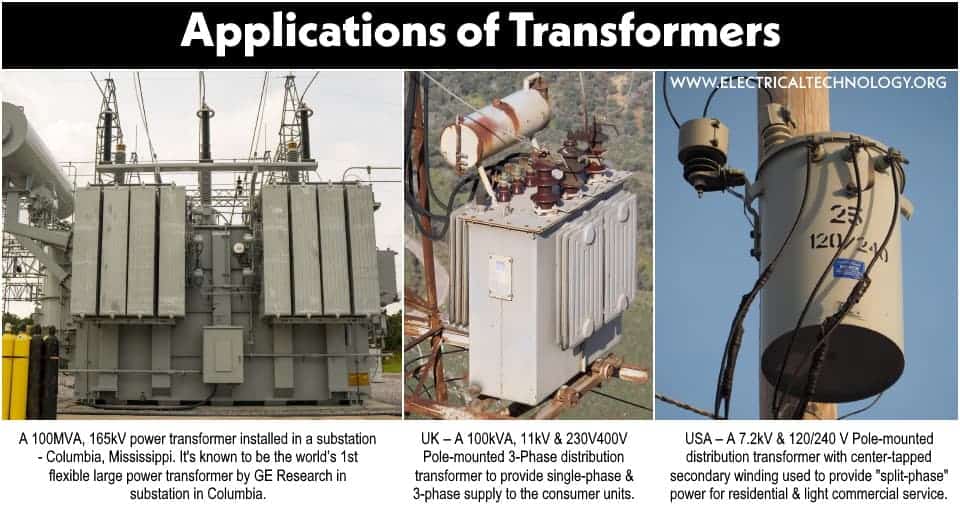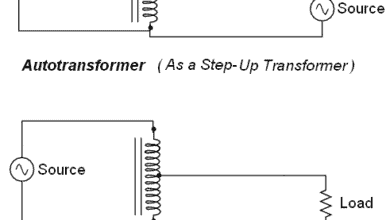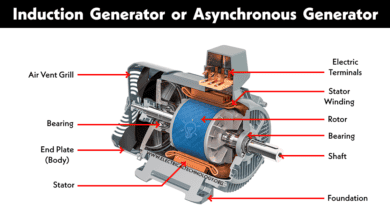Applications of Transformers
Uses and Applications of Transformers
The operating principle of all kinds of transformers designed for different applications are the same e.g. electromagnetic induction whereas the applications of transformers are different based on the system requirements. The main application of a transformer is to step-up or step-down the level of voltage or current in power plant generation stations, receiving end substations and distributing the electrical power to the consumer units for domestic and industrial applications.
The primary function of an electrical transformer in a power system is to adjust the AC current or voltage level, either stepping it up or stepping it down, while maintaining a constant frequency and power output. The customized level of voltages are used to transmit and distribute electric power to the end users e.g. residential and commercial consumers.
Keep in mind that DC power transmission has some advantages over AC power transmission. However, the initial cost of DC transmission is much higher. For this reason, AC transmission is preferred over DC in most cases, as it is more cost-effective. Changing the values of AC voltage is easily done by a transformer. DC voltage can’t be step up/down using a transformer because a transformer can’t be operated on DC. For this reason, buck and boost converters are used to adjust the level of DC voltage according to the needs of the systems.
High frequency reactors and chocks based on low noise and small size transformers are also used in UPS, CVCF (Constant Voltage Constant Frequency), VVVF (Variable Voltage Variable Frequency), railway car auxiliary power supply and dispersed power sources. The shunt reactors (single winding per phase) is also used to absorb and compensate the reactive power in cables and high voltage long transmission lines. This process leads to increase the efficiency of the transformer, overall power and energy systems.
High frequency transformers are used in medical X-ray power supply, welding machines and high frequency power supply equipment.
Rotary transformers are used for high speed motor & generator, axial gap motor/generator and high pole number motors and generators.
Instrument transformers are also widely used in the electrical systems and networks. For example, CT (current transformer) is used to measure the current of another circuit and monitor the high voltage lines across power grids.
On the other hand, PT (voltage or potential transformer) are used to step-down the high level of primary current and voltage to the lower level of voltage and current as output in the power system. In addition, autotransformer are used for compensation of the voltage drop in the distribution transformers, starting induction and synchronous motors, to achieve continuous variable output voltage and mostly, to interconnect many systems operating at different voltage levels.
At last but not least, yoke shunt / tank shield or magnetic shunt transformers are used to reduce stray losses in the tank of large size transformers.
- Related Post: Applications of Electric Motors
Common Applications of Transformers
Transformers have a wide range of applications in various fields. Here are some common applications:
- Voltage Transformation: Transformers are primarily used to step up or step down voltages in AC circuits. Step-up transformers increase voltage for transmission over long distances, while step-down transformers reduce voltage for distribution to end-users.
- Power Distribution: In power distribution systems, transformers are used to reduce high transmission voltages to lower values suitable for consumer use.
- Electrical Isolation: Isolation Transformers provide electrical isolation between the input and output circuits, which is crucial for safety and preventing ground loops.
- Impedance Matching: Transformers are used to match the impedance between different parts of a circuit, ensuring maximum power transfer.
- Signal Coupling: In audio amplifiers and telecommunications systems, transformers are used for coupling signals between different stages of a circuit while providing electrical isolation.
- Voltage Regulation: Auto-transformers can be used to regulate voltage by adjusting the tapping point on the winding.
- Power Supplies: Transformers are used in power supplies to convert AC voltage to DC voltage using rectification and filtering circuits.
- Induction Heating: High-frequency transformers are used in induction heating applications to heat metals without direct contact.
- Instrument Transformers: Current transformers and potential transformers are used in metering and protection systems to measure high currents and voltages safely.
- Audio Transformers: In audio equipment, transformers are used for impedance matching and to eliminate ground loops, improving sound quality.
A transformer is generally used in different applications due to the following features and characteristics.
- It can raise or lower (step-up or step-down) the level of AC voltage or current. When voltage increases, current decreases, and vice versa. This is because P = V × I, where power (P) is constant at both input and output sides. This setup is used in both power transformers and distribution transformers for the transmission and distribution of electric power in a power system for further utilization and applications.
- It can increase or decrease the value of capacitance, inductance, or resistance in AC circuits. A transformer thus acts as an impedance-transferring device.
- It can be used to prevent DC from passing from one circuit to another. In other words, they are used as ripple filters that compensate for pulsating DC.
- It can be used to electrically isolate two electric circuits.
- Related Post: Applications of Diodes
Application of Transformer in a Power System:
A power transformer steps-up the level of voltage at the generation side before transmission and distribution. For example, it increases the level of generated voltage in power plants from 7200kV-12kV to 33kV, 66kV, 220kV or even more up to 400+ kV for power transmission to the distribution centers.
In the distribution centers, the distribution transformer steps-down the level of voltage for commercial and domestic use of electricity. For example, it decreases the level of voltage from 11kV to 230V single phase and 400V three phase (UK and IEC). In the US and Canada, the utility transformer steps-down the level of voltage from 7200V to 120V, 240V (most common residential via center-tapped transformer), 208V, 277V and 480V in the US and Canada.
Finally, autotransformers, shunt-reactors, current transformers and potential transformers, are also used in a typical power system. Additionally, transformers are also used for impedance matching.
Click image to enlarge
In the given fig above (from left to right)
- A 100MVA, 165kV power transformer installed in a substation – Columbia, Mississippi. It’s known to be the the world first flexible large power transformer manufactured by GE research.
- A 100kVA, 11kV & 230V400V Pole-mounted 3-Phase distribution transformer to provide single-phase & three-phase supply to the consumer units – UK.
- USA – A 25kVA, 7.2kV & 120/240V Pole-mounted distribution transformer with center-tapped secondary winding used to provide “split-phase” power for residential & light commercial service – USA.
Related Posts:
- Why Transformer Rated In kVA, Not in KW?
- Parallel Operation of Single-Phase & Three-Phase Transformers
- EMF Equation of a Transformer
- Transformer’s Losses – Types of Energy Losses in a Transformer
- Equivalent Circuit of Electrical Transformer
- Transformer Performance & Electrical Parameters
- Power Transformer Protection and Faults
- Transformers Insulation Materials in Oil-Immersed & Dry Type T/F
- Transformers Fire Protection System – Causes, Types & Requirements
- Advantages and Disadvantages of Three Phase Transformer over Single Phase Transformer.
- Transformer Phasing: The Dot Notation and Dot Convention
- Can We Replace a 110/220 Turns Transformer with 10/20 Turns?
- Electrical Transformer Symbols – Single Line Transformer Symbols
- Can We Operate a 60Hz Transformer on 50Hz Supply Source and Vice Versa?
- Which Transformer is More Efficient When Operates on 50Hz or 60Hz?
- Difference Between Single Phase and Three Phase Transformer
- Difference Between Ideal and Real or Practical Transformer
- Transformers (MCQs With Explanatory Answers)







Nice post! It is very interesting.
Thanx Dear
this we already know<br />
But everyone dont know.
Dear Anonymous.. if u know any further information u post it in the comment…<br />This is very useful information
thank you for simplifying things :)<br />It is really good for students just started studying electrical engineering!
Most Welcome Dear
Thanks for your works
Welcome Dear
Thanks for your contribution, this information's are very helpful.
Welcome Dear
thanks for your information<br />
Welcome Dear
this help me a lot for my presentation thanks :)
Welcome Dear
is there transformer having an input with 12volts while the output has 0v,3v,6v,9v and 12v.. the sequence of that is DC to AC ?? plss response as soon as possible.. ??
What is buck and boost???
can we convert ac into dc using transformer?
No
hi. how can i cite this page? thanks :)
Thanks diz rilly helped mi a lot am greatful
mam/sr. can i ask something ? is there a transformer having an input 12v while the output has 0v upto 12v. that sequence is DC to AC so i mean the transformer can provide the AC output? because my source having 12VDC.
A Transformer does not work on DC … Read more here : What will happen if the primary of a transformer is connected to DC supply? but if you want to do so, Then first convert AC to DC and then use DC to DC converter
Dear Sir, Kindly upload another models of single phase transformers (Step down) and its inside pictorial view, different disigns like iron core type and other core types also to know the pople about the valuable transformers how the connectivity to input and out put also. increase the subject deeply which the different transformers are using in the field of electronics (SMPS circuits) ans as well as in audio circuits.
Thanking You Sir.
IT IS SO INERESTING. IT STIMULATES MY CURIOUSITY AND EAGER TO LEARN AND KNOW MORE.
Thank you for helping me
Transformers have lot of advantages that can work on an AC circuit to optimize the flow or current or voltage levels. Moreover they are the best alternatives to conventional circuits that are devoid of the usage of magnetic induction principle to control the voltage flow.
Thanks for your kind information about transformer it is really helped me
thank you.this was helpfull
it helped me a lot in completing my project.thank’s a lot
I didn’t realize that a transformer could actually increase or decrease the value of a capacitor. That seems like it could be really important for an electrical system. I see a lot of pole mounted transformers around, and I have always been curious what they do. Thanks for the information!
Good day sir’s I was so happy and gland of what I found on this my research,what I found from u will help me a lot on my further education by god grace. I greet u, may Almighty Allah grant u and protect u in ur future.